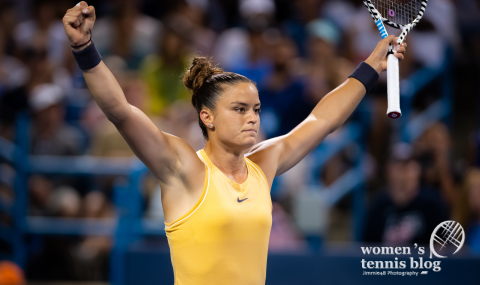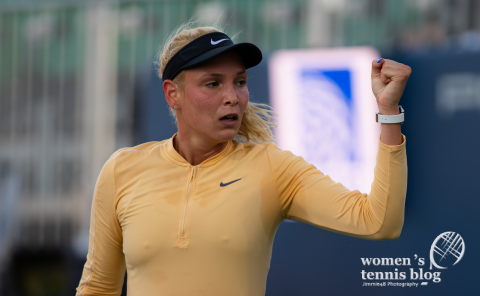In this month’s column, coach Marcin Bieniek, founder of instructional Enjoy Tennis Blog, will talk about the issue of pressure in tennis — how to deal with it and how to put pressure on your opponent.
Competitive sport requires complex preparation and tennis is no different. Players have to work consciously on different aspects to build strengths that will allow them to get advantage on the court. The higher the level, the more we can hear that tennis is a psychological sport and players who have solid mental skills are the ones on the top.

Tennis players are by themselves on the court, with no time limit for the match. Every good shot shows their good abilities, while every mistake can be a reason for self-doubt. The individual character of the game puts a lot of pressure on athletes — and pressure is key to learning the winning formula.
We all know how difficult it is to deal with stress and at the same time perform your best. Pressure has negative impact on functioning of the body and mind, so that is why only really skilled athletes with good mental preparation are able to get on the court full of crowd and expectations and still deliver their best shots. Those who are not as skilled start to have stiff body, move slower and rush decisions. Additionally, they have low self-esteem and their reactions are many times based purely on emotions. All these factors prove that it is important to learn how to put pressure on opponents and to have abilities to deal with the stress that the rival or environment put on us.
There are different ways of putting pressure in tennis. Being aware of them, practicing them and using them during matches is the skill that has to be developed to be able to put opponents into uncomfortable physical and mental states. During the match, there is always some kind of stress, but it doesn’t mean that only the environment can create challenges for athletes. We can do a lot of things with the ball to make sure that it is much harder for the rival to beat us.
Power
The easiest way to put pressure on the other player is by increasing power of your shots. By adding some speed to the ball, you give less time for reaction to the opponent. It means that the rival has less time for preparation and decision-making. If athletes don’t train in these uncomfortable conditions, there is no chance that they will be able to answer these balls effectively during competition.
 Position inside the court
Position inside the court
In tennis, players don’t have a lot of time to prepare their shots. When the ball is coming at the speed of over 100 km/h, you have to be really well-prepared physically and technically to be able to control the ball with expected direction and depth. That is why it is a wise move to stay closer to the baseline and use every opportunity to step inside the court and put more pressure on the opponent. Focus on reading the ball as fast as possible, and every time you have a shorter response, make sure that you are in the court.
Depth
Playing balls close to the baseline is another option to put pressure on the opponent. Giving less time for reaction and also forcing the opponent to move back are two benefits of executing this strategy. At the top level, we can see that players send a lot of balls deep, so their rivals don’t have many chances to attack them from the baseline. It is important to combine solid power with controlled spin to make sure that this kind of ball can be repeated many times.
Direction
It is much easier to execute shots while not moving to them, so to put pressure on the other player it is a priority to play balls to the sides. There are different tactical options, like playing to the weaker side, or hitting balls to the stronger side to open the other half of the court, but each of them is based on moving the opponent. Playing on the run requires more skills than executing balls from the center of the court, so this opportunity to put pressure should be planned before every point.
Take risks
Sometimes it is better to play safe balls, but sometimes risky shots can give you more chances to win the match. Brave players reach for trophies, but there is a difference between risky-calculated shots and careless decision-making. Working on situational shots will give you experience and wisdom to decide when you should take some more risk and accept what it will bring. When you look at champions, they don’t always play it safe — they know that to beat great players they have to take responsibility and look for solutions that are not first choices for the rest of players.
Like it or not, pressure is present in tennis all the time. Planning some psychological and tactical strategy for the upcoming match, including putting pressure, will always give you more unforced mistakes from the other side of the net and take you closer to leaving the court as a winner.
MORE TENNIS TIPS BY COACH MARCIN BIENIEK:
- Professional approach to tennis warm-up
- The priorities of successful passing shots
- How to make your return effective
- How to deal with a lost tennis match
- Tennis strategy to play well in hot environment
- How to improve footwork in tennis, 3 crucial moves to practice
- Transferring tennis practice performance to the tournament environment
- Hardcourt tennis tips, four skills you must work on
- Self-rate your practice session
- Recovery and healthcare techniques to improve your tennis
- How nutrition affects our mental readiness in tennis
- Does one need private tennis lessons?
- How to maximize quality of tennis training sessions
- Post-practice routine for best tennis results
- How to play tennis in the summer heat without getting exhausted
- The reasons you absolutely have to play tennis on all surfaces
- 3 simple products parents miss to buy to help their kids excel in tennis
- How to improve reaction skills in offensive, fast-paced tennis
- How to control anger and frustration to win a tennis match
- Tennis tips: 3 areas that cost you too many points
- How to practice serve the right way
- Coaching tips: How to avoid mistakes in tennis
- Things to (not) do on vacation to improve your tennis game
- How to translate your tennis practice into match wins
- How to build team spirit in tennis
- How to become a master of claycourt tennis
- How to make your serve more effective
- How to choose the best tennis racquet to fit your level, playing style and body type
- How to handle playing tennis in sunny conditions and even take it to your advantage
- 5 portable fitness tools for serious tennis players
- Best foam roller exercises for tennis players





“Brave players reach for trophies, but there is a difference between risky-calculated shots and careless decision-making”
This is the key!